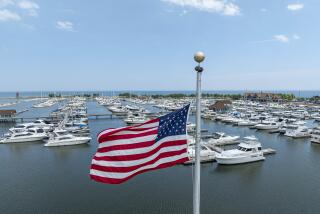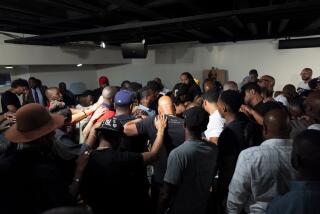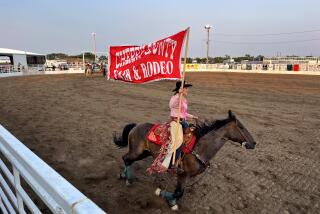Ohio voters’ love is tough to win
CHILLICOTHE, OHIO — Whoever wins the crucial Ohio Democratic presidential primary Tuesday, thanks will probably be owed to the likes of Jim Aldrich, a 61-year-old union worker at the Glatfelter paper mill on the southern edge of this small industrial city.
But even Aldrich doesn’t know from whom to collect the “thank you,” because he still hasn’t decided what he is going to do in the voting booth.
“It might be one of those elections where you just go in, close your eyes and take what you get,” Aldrich said as he stood outside the Paint Grill bar, the smoke from his cigarette mixing with the sour stench from the paper mill next door.
In a primary campaign destined to break one of two glass ceilings -- gender or race -- the contest between Sens. Hillary Rodham Clinton of New York and Barack Obama of Illinois for the nomination could pivot on the political choices of white, working-class men like Aldrich.
In the earlier primaries, that bloc of voters shifted by state, sometimes going with the winner -- Obama in Virginia, Clinton in California -- but forming a counter-tide elsewhere. Clinton won New Hampshire but Obama did better among blue-collar men. The orders reversed in Georgia.
But Obama did well among blue-collar men in Wisconsin, a shift that some say might be a prelude to whatever happens here Tuesday. A Reuters/C-SPAN/Zogby poll released Saturday found that Obama had erased a Clinton lead and made the state a dead heat, though other polls still give her the edge.
“White male voters are beginning to open up toward Obama,” said John Gilliom, a political analyst at Ohio University in Athens. “Ohio seems to be a few days slower than other states in the way some of the polling has moved. . . . But we’re definitely seeing the same pattern.”
A key development: Obama’s winning the Teamsters union’s endorsement, which Gilliom said “has a heck of a lot of cultural clout.”
“If you’re trying to make room for a bumper sticker that says, ‘Real Men Vote for Obama,’ the only thing better than the Teamsters is the NRA, and he ain’t going to get the NRA unless the sun comes up over California tomorrow,” Gilliom said. “But getting the Teamsters . . . is getting to the point where it’s no longer a leap of whimsy [for blue-collar workers] to say you’re an Obama voter.”
It’s not necessarily an easy embrace. Even staunch Obama supporters here say thin slices of the electorate are not ready to vote for a black man for president, even though two of Chillicothe’s 10 city council members are black. Census figures show 7.5% of the city’s population is black, compared with 12.3% nationally.
During the January celebration of Martin Luther King Jr. Day outside the Ross County Courthouse, a white man sat in his pickup truck with a tailgate sign that read: “A real white person would not march for MLK.”
Some see a similar vein of resistance to voting for a woman.
“Part of what [Obama] is getting are some of the union men who were supporting Edwards, and when they were left without a candidate, they went to Obama,” said Jim Bennett, a substitute teacher and former Presbyterian pastor who is one of Obama’s key volunteers in Chillicothe. “I wonder if part of it is sexist.”
Bennett recalled a recent conversation with a “sort of nominal” Democratic friend in Piketon, midway through the low hills between Chillicothe and the Ohio River, who told him: “You Democrats finally got what you wanted -- a black man or a woman.”
“A lot of them do not like either one,” Bennett said. “Those people will probably vote for McCain, so we’ll be dealing with that in November.”
As in most of the old Rust Belt, the economy here has been pummeled, though with few employers tied to the steel or auto industries the slide hasn’t been as bad as in the northeast part of the state, near Youngstown and Akron. Still, jobs are disappearing. The December unemployment rate for Ross County was 7.5% -- compared with a state rate of 5.8% and a national rate of 4.8%.
Steve Neal, the county’s elected auditor and a Clinton backer, thinks Obama’s themes of hope and change could be winning over those most buffeted by economic winds.
“They’re kind of tired of where we’re at right now,” Neal said. Despite Obama’s appeal, Neal said, he believes he is the less proven candidate.
Regardless of misgivings about the candidates, expressed or not, there is plenty of open support for both.
Reflecting a national split, Clinton seems to have the support of the Ross County Democratic Party leaders, although the county committee officially remains neutral. Obama’s support is anchored by local progressives and, in many cases, former Howard Dean supporters.
But Obama also has galvanized the support of voters like Rick Conkel, 49, a vocational school administrator who voted for George W. Bush in the last two presidential elections.
“We’re not political people,” Conkel said, sitting beside wife Christy as they waited Thursday night to hear Michelle Obama speak at the local YMCA gym. “I’ve got an Obama sign in my yard, and I’ve never had a political sign in my yard before.”
Steve Madru, a local real-estate agent and the Democratic Party county chairman, has lined up behind Clinton.
He compares the Clinton-Obama decision to a choice between cars. He recently leased a Mercedes after a lifetime of buying American cars and found his affection faded quickly for the snazzy import -- yet the lease won’t run out for three years. “It’s like you’re riding your old Lincoln, like I done for many years,” Madru said of his support for Clinton. “It’s comfortable. I know it.”
At the local Amvets Club at the edge of downtown, Vietnam War Navy veteran William W. Jones said he likely would be voting for Obama. Nursing a beer on a rainy afternoon, he parsed the role racism and sexism might play among his fellow Democrats -- some of whom he has heard speak harshly about both candidates.
But he ascribes most of the jokes and dismissive talk to small-town white culture, seeing it as role-playing more than embedded belief.
“A lot of the older guys I’ve heard say, ‘I’m not voting for a black; I’m not voting for a woman,’ ” said Jones, who is white. “My dad, if he was around, he’d be having a fit. But I don’t think that’s really going to matter when it gets right down to it. I’ll bet you any amount of money when they get in the booth, they’ll vote for Hillary or Obama.”
--
--
(BEGIN TEXT OF INFOBOX)
Ohio snapshot
--
In the 2004 presidential general election, about 66% of Ohio’s voting-age citizens cast a ballot, just over the national figure of 64%. Here’s how the Buckeye State compares to the U.S.:
Population
Ohio: 11.5 million
United States: 304 million
*--* -- Ohio U.S. Male: 48.8% 49.2% Female: 51.2% 50.8% *--*
Rank of population: 7
Median age
Ohio: 37.6
--
United States: 36.4
Race/ethnicity
*--* -- Ohio U.S. White 83% 66% Black 12% 13% Asian 2% 4% Latino 2% 15% *--*
Education
*--* -- Ohio U.S. High school -- -- graduate or -- -- higher 86% 84% Bachelor’s -- -- degree or -- -- higher 23% 27% *--*
Pledged delegates at stake
--
Democratic: 141
Republican: 85
--
Income/housing
*--* -- Ohio U.S. Median -- -- household -- -- income $44,532 $48,451 Median -- -- home -- -- value $135,200 $185,200 *--*
More to Read
Sign up for Essential California
The most important California stories and recommendations in your inbox every morning.
You may occasionally receive promotional content from the Los Angeles Times.










